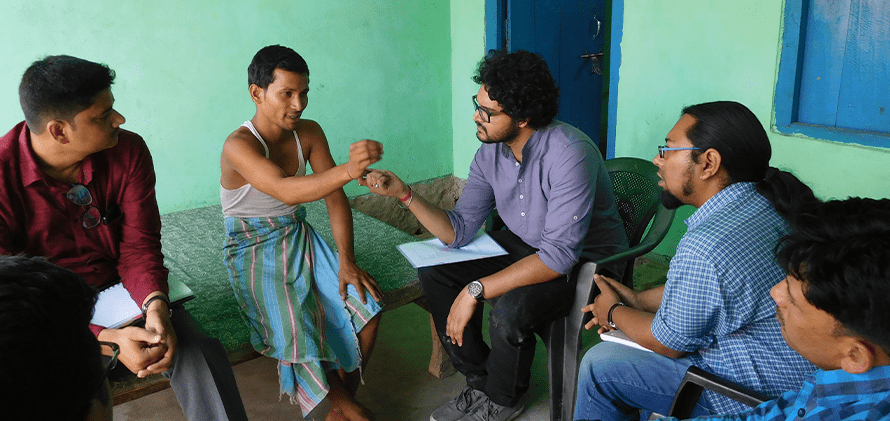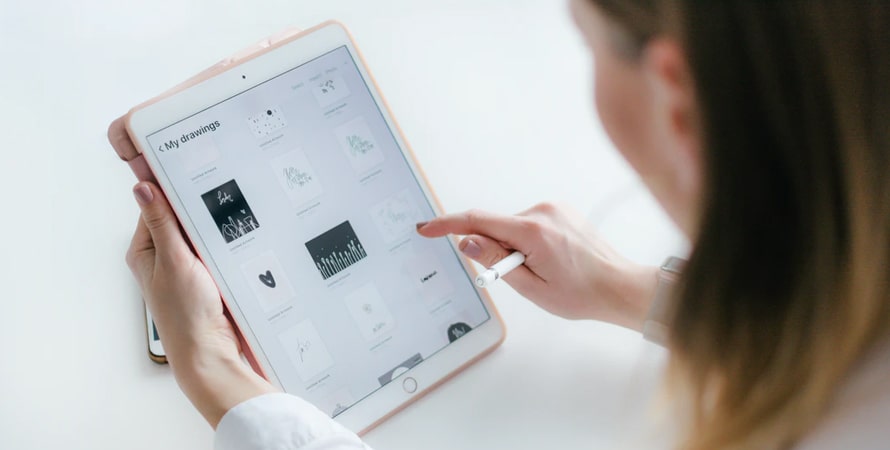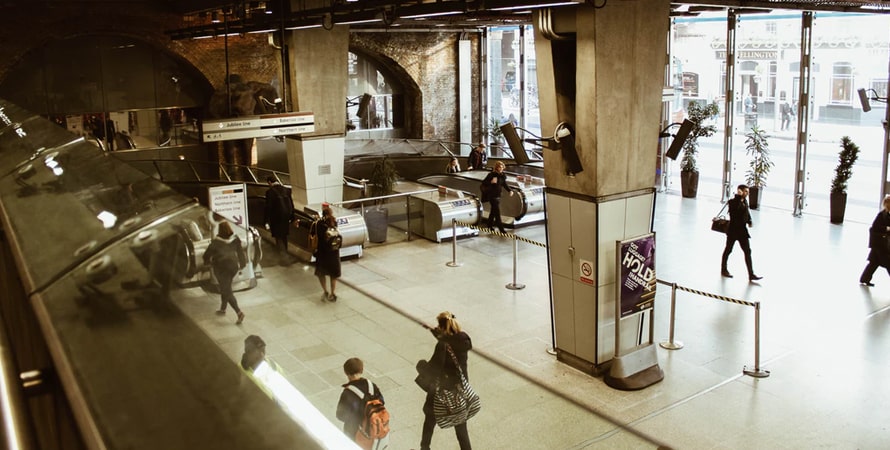Pratishtha Aswal & Mohita Jaiswal - June 2020

While probing and observation methods find popularity to understand user beliefs and perceptions, we need to start conceptualizing ways to conduct high quality fieldwork based research in locations where we can not be physically present and in situations where we have to rely on people who may not be trained field researchers.
Making our way through the Golden Grid
Think Design’s Golden Grid is a framework for planning user and design research. Fundamentally, all the research methods are based on one of these four approaches to conduct research.
- Methods that involve observation and analysis of information/data.
- Methods that involve observation, questioning and/or testing with users
- Methods that involve immersing in the context and experiencing the situation with probing
- Methods that involve exercising empathy by thinking and doing
Think + See
Information/ Evidences/ Data
Outcome: Understanding or insights based on recorded or real-time information.
- Audio/ Video Analysis
- Critical Thinking
- Diagnosis
- Document Research
- Heatmap Analysis
- Social Network Mapping
- Time Lapse Video
- Trend Analysis
- Usage Analytics
Act + Think
Hypothesis/ Synthesis
Outcome: Hypothesis or synthesis demonstrated through visual or verbal communication.
- A Day In The Life
- Audits
- Be your Customer
- Bodystorming
- Customer Segmentation
- Heuristic Analysis
- Informance
- Persona
- Predict next year’s Headline
- Prototyping
- Role Play
- Role Reversal
- Scenarios
- Simulation/ Modeling
- Try it Yourself
See + Probe
Perceptions/ Opinions/ Validations
Outcome: Understanding or insights based on what people said or demonstrated.
- Card Sorting
- Concurrent Probing
- Contextual Inquiry
- Diagnosis
- Dyads & Triads
- Extreme User Interviews
- Five Whys
- Fly On The Wall
- Focus Groups
- In-depth Interviews
- Personal Inventory
- Retrospective Probing
- Shadowing
- Surveys
- Tree Test
- Unfocus Group
- User Testing/ Validation
- Word Concept Association
Probe + Act
Experiences/ Design Bases
Outcome: Understanding or insights based on researcher’s own interpretation of context.
- Brainstorming
- Business Model Canvas
- Ethnography
- Guided Tour
- Participatory Design
- Task Analysis
- Visit Survey
- Workshop
Here methods that are a part of quadrants on the left hand side of the grid i.e 1 and 3, are those which can be conducted remotely with relative ease.
This is so as methods in quadrant 1 can allow a researcher to discover insights through analyzing recorded or real time information. For example in usage analysis a user is made to complete a series of tasks, attending sessions remotely and the recorded data and event information is used to make inferences. While methods in quadrant 3 allow us to create a synthesis or hypothesis basis the information already gathered by a researcher. This synthesis is created by either analyzing the data or simulating scenarios, to exercise empathy.
The challenge lies in conducting research methods in quadrants on the right side of the golden grid, i.e 2 and 3, as both involve the researcher to generate insights based on what the users said or demonstrated or what the researcher experienced while immersing in a context.
We focus on these to understand the extent to which these methods can be conducted remotely without jeopardizing the intent of the entire exercise.
1. Ethnography
Ethnography is a creative process of discovering and mapping the cultural patterns within a group where the intent is to create a link between the cultural background of a group and how this culture influences the behavior of individuals who are part of this group. Through investigating everyday social life and giving a description of the culture of a group of people, ethnographers understand everyday product experiences and the processes of design.
The notion of field-based research was first established by Polish anthropologist Bronislaw Malinowsk (1922), who based on his long-term research in the Trobriand islands, establishing the view that being in the field for a significant period of time was the main method by which anthropologists could understand and represent peoples and cultures, authentically.
Is a remote alternative possible?

S.No.
Aspect of the method
Digital alternative and challenges
1.
Building the research questions
Before the interview, depending on the theme, respondents can be asked to send collected photos or videos recorded by themselves, which can be analyzed and classified further.
It can capture the thoughts and feelings of users towards products and services. Also showcase actual using conditions through photos taken and comments made by respondents which can be a useful precursor to create research questions.
2.
Conversation and engagement with groups of people to gain an understanding of the participant’s culture and behavior
Conduct interviews by using a videoconferencing tool or telephone.
Local partners can visit the respondent’s house together with a video camera as a tool supporting the remote researcher to conduct ethnographic interviews from a distance.
Local partners, if not aligned and in-sync with researchers, could jeopardize the participant’s trust in the process and their openness to share.
3.
Researcher needs to observe the participants and listen carefully
Researchers can ask participants to speak in turns to enhance their understanding. Recording can help to eliminate the researcher’s bias.
Another remote researcher can assist to note non-verbal gestures and expressions of participants.
First hand insights are more reliable as non-verbal cues can be noticed more easily in the physical presence of a person.
4.
Large amount of time is spent with the participants to understand them
The length of the time spent with the participants, probing and observations leads to rich and detailed data collection.
However, relationships with participants in ‘the field’ could be forged effectively and maintained through long term digital-visual communications.
2. Contextual Inquiry
Contextual Inquiry is a method where participants are observed while they perform tasks and simultaneously talk about what they are doing while they perform them. The challenge in employing this method remotely is about observing and probing a participant who is demonstrating a task/process while in their natural environment, without breaking the flow of the participant, or affecting their work.

S.No.
Aspect of the method
Digital alternative and challenges
1.
A common understanding of the task that users are going to perform is developed
Using a standard questionnaire and logbook template to fill in before the interview, a common understanding of the task to be performed can be arrived at.
2.
Participants take the position of a subject matter expert, leading the session by demonstrating and talking about their tasks.
A screen sharing conference can be done, asking the user to explain each task while sharing the screen. For tasks involving usage of digital screens, screen recording can be used which records user clicks and where the cursor moves in real time.
The researcher could constantly probe the user, by asking clarifying questions on actions and information shared.
The tasks can also be split up among different participants to observe and understand all tasks in depth and not exhaust or tire down one participant.
3.
Contextual inquiry is performed in the participant’s natural environment so the insights are closely connected to the participants and their tasks.
Constraints of availability of tech in the natural environment exists. Tech problems due to bandwidth issues can cause drop offs, screen freezes,causing loss of observational input.
Having 2 people on the team, where one can be taking notes and one leading the interview can help.
Contextual Inquiry in a remote manner is also being used as a research technique that allows software teams to remotely view how software users interact with the system and the types of software customizations that have been made. Understanding how users interact with the software and the types of customizations made during implementation, can help designers and product managers prioritize existing features for redesign and describe the need for new features.
3. Shadowing
In shadowing, researchers observe real-life situations of a research subject or participant for a set period of time. Shadowing leads to collection of information which should be further investigated and synthesized and the end objective is not gaining a direct validation.

S.No.
Aspect of the method
Digital alternative and challenges
1.
Researcher does not interfere with the participant to avoid the research subject to deviate from their natural behavior under the scenario or circumstance.
Observations should be recorded as they are made, though care should be taken not to allow this to distract from other observations, in a fashion that allows reconstruction of the behavior at a later date.
This can be done via screen recording and photographing the participant at certain points during the exercise.
2.
The time of shadowing can vary from 30 minutes to a few weeks or months depending on what the design researcher wishes to learn from the exercise.
Care should be taken to avoid videoing a subject for hours and hours on end. It is very unlikely to be valuable to spend as much time on analysis as on the observation itself.
However trying to capture it for a limited time period might serve as counterintuitive to the idea of observing the subject in depth.
3.
In controlled shadowing – the researcher designs a task and observes it being carried out.
If the participant to be observed will be mobile during the observation – care should be given to ensure that the observer can move easily (or the screen can be rotated by someone) so as not to interfere with the natural motion of the subject.
A local observer might be needed to assist in capturing the video observations as the subject is in motion.
4. Focus groups
A focus group is a qualitative research method which is employed to find out different attitudes, responses about a subject. Remote focus groups are required to navigate through challenges of gaining objective and diverse feedback from a group of participants online.

S.No.
Aspect of the method
Digital alternative and challenges
1.
Customer experience can be simulated within a focus group and feedback can be collected on that experience
Remote focus groups with video conferencing, lets users participate in more natural environments, like their homes, removing some of the uncertainty and shyness that focus group participants can experience.
It also provides a bit of anonymity, so test participants are more comfortable giving honest feedback.
2.
Interpreting from non verbal cues of participants and getting a sense of the entire group
An observant researcher can interpret the participant’s mood from their body language as well as tone of voice and use them as a cue to probe further..
When the conversation is happening remotely, however, there are multiple screens of content, chats, and (in some cases) camera feeds to watch.
Recording can be used to capture those subtle markers of experience, like facial cues and body movements.
3.
Engagement of participants in the conversation
Conducting a focus group in person, it becomes easy for participants to return to the conversation, but in a remote setting, it’s easier to remain distracted.
Whenever possible, it’s important to give users something visually stimulating, in addition to the conversation.
4.
Creation of a space for diversity of opinions, discussions and debates
In groups, peer pressure can influence participants to conform to the dominant opinions of the group.
In a remote focus group(conducted without webcams) this can be alleviated, as the visual, environmental cues that indicate the participants agreement or disagreement to something, get diluted in a remote setup. The facilitator can then make a point of encouraging any dissenting opinions.
5. Fly on the wall
Fly on the wall research is an observational technique that allows a researcher to collect data by seeing and listening. Usually researchers employ this method to gain insight into people, environment, interactions and objects in a space. However the challenge in conducting this remotely is because the primary responsibility of the researcher is to stay completely unnoticed during the observation so as to not bias the participants in any way.

S.No.
Aspect of the method
Digital alternative and challenges
1.
Minimal/negligible researcher intervention
As the researcher is only observing, not verbally probing or intervening during this data collection exercise while being unnoticed, screen recording in such a context cannot work.
Installing video cameras/drones without permission of the subject violates privacy, as they could be subject to manipulation.
2.
Location is participant specific
3.
Observe people and environment together, without your presence being felt.
Improvising ‘traditional’ through digital
Methods such as card sorting, extreme user interviews, surveys, user testing are already being simulated with online alternatives and tools available to carry them out digitally. Other research methods which involve group participation to ideate and participate, such as, brainstorming, business model canvas, workshops and participatory design are also possible remotely, utilizing new-age video conferencing tools.
In times when coming together becomes challenging and physical distances jeopardize our attempts to understand our users, we need to put our creative hats on to collaborate differently. Digital and remote can become a new reality for design researchers, bringing in clear positives of a possibility of encompassing diverse global perspectives along with an increased quality of available data and methods of analysis.
When done correctly, this would accentuate creation which is more relevant, usable and viable for our masses.




